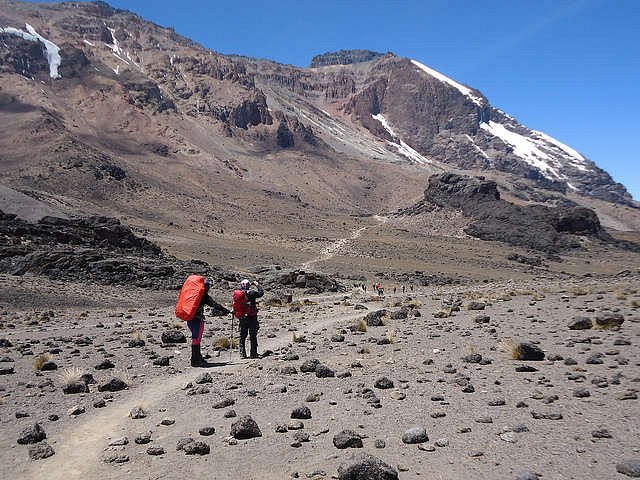Umbwe Route – The Steep, toughest & Most Demanding
Umbwe route of Climbing Kilimanjaro is located in the southern part of Mount Kilimanjaro. The Umbwe Route is renowned for its steep and challenging trail. It’s considered the toughest and most demanding route, featuring rapid ascents and steep inclines that require significant physical effort and prior training for adequate acclimatization. The route is favored by experienced adventurers seeking a challenging mountain hiking experience, as it traverses rocky terrains.

Trekkers tackling the Umbwe Route must possess exceptional fitness and stamina, especially since the relentless ascent presents challenges even to seasoned hikers. Due to its steepness, the success rate on this route tends to be lower compared to others. Proper preparation is crucial, as trekkers have limited time during the ascent to acclimatize. Success often comes to those who engage in prior exercise and yoga training, ensuring they are in optimal physical condition for the uphill climb over the initial days. Unlike routes that allow for gradual acclimatization through gentler ascents, the Umbwe Route demands a strenuous push toward the summit. However, as trekkers journey along the trail, they are rewarded with breathtaking views of the landscapes that adorn the route, making it a preferred choice for hikers on Mount Kilimanjaro.
The trek along the Umbwe Route offers a uniquely beautiful experience, with fewer travelers venturing along this path, reducing competition for camping sites. This allows hikers to enjoy the mountain in relative solitude, without the presence of large crowds often encountered on popular routes like the Coca-Cola and Whiskey routes. Choosing the Umbwe Route provides an opportunity to capture stunning photos and videos without distractions, as you ascend uphill.
As the Umbwe Route progresses, trekkers eventually join the Machame Route near Barranco Camp, encountering other hikers briefly before continuing their journey to the summit of Kilimanjaro. The route then traverses the Southern Circuit beneath the Southern Ice Field, culminating in the ascent from Barafu Camp, ultimately leading to the summit.
For those seeking unparalleled views and relishing the challenge of wilderness exploration, the Umbwe Route offers an unforgettable adventure. It’s an opportunity to test one’s limits and embark on a true mountaineering expedition on the iconic Kilimanjaro. Climbing Kilimanjaro offers both group and private climbs, with the option of a seven-day variation including an acclimatization day at Barranco Camp.
6-Days Mount Kilimanjaro Trek on the Umbwe Route
Day 1: Umbwe Gate to Umbwe Cave Camp Begin your journey at Umbwe Gate, where you’ll sign in before embarking on a six-hour trek through the forest. Follow the twisting trail alongside the Umbwe River, surrounded by lush vegetation providing shade as you ascend. Reach Umbwe Cave Camp by nightfall, located at approximately 2,900 meters above sea level, where you’ll set up camp and prepare for the adventures ahead.
Day 2: Umbwe Cave Camp to Barranco Camp
Depart Umbwe Cave Camp and venture into the Montane Forest for a four to five-hour trek. As you make your way toward Barranco Camp, catch glimpses of the imposing Western Breach and the majestic Great Barranco, adding to the sense of adventure. Arrive at Barranco Camp, your resting place for the night, and immerse yourself deeper into the beauty of the wilderness.
Day 3: Barranco Camp to Karanga Camp
Embark on a thrilling scramble up the Great Barranco Wall, followed by a trek to Karanga Valley. Set up camp at Karanga Campsite, nestled beneath towering icefalls, and surrounded by breathtaking views of icy peaks above.
Day 4: Karanga Camp to Barafu Camp
Trek toward Barafu Camp, taking approximately three hours to reach the junction with the Mweka descent Trail. Continue to Barafu Hut, where you’ll rest and prepare for summit day, while enjoying stunning views of Mawenzi and Kibo peaks.
Day 5: Barafu Camp to Uhuru Peak to Mweka Camp
Rise early for summit day, setting off for Stella Point along the path to Uhuru Peak, the highest point in Africa. Take each step carefully as you navigate the rocky and steep trail, focusing on reaching your goal. Celebrate your achievement at Uhuru Peak before descending to Barafu for lunch. Continue to Mweka Hut for a well-deserved rest.
Day 6: Mweka Camp to Base Hotel/Departure
Descend to Mweka Park Gate, receiving summit certificates upon arrival. Trek through muddy trails, reflecting on the incredible journey as you make your way to the base hotel.
Frequently Asked Questions About The Umbwe Route Of Mount Kilimanjaro
Q: What is the best time to visit Mount Kilimanjaro via the Umbwe Route?
A: The optimal time for trekking the Umbwe Route is from July to September due to stable weather and lower chances of rain. However, Mount Kilimanjaro’s proximity to the equator allows for climbing year-round. It’s advisable to avoid the rainy season in April and May, as rainfall can hinder the trekking experience, making trails slippery and summit attempts dangerous. Planning the trek during recommended months maximizes the chances of a successful and memorable adventure.
Q: How difficult is the Umbwe Route, and what is the success rate for hikers?
A: The Umbwe Route is known for being the shortest but most challenging route on Mount Kilimanjaro. It features steep inclines and limited time for acclimatization, resulting in a lower success rate compared to other routes. While success requires good physical fitness and readiness to tackle strenuous terrain, the route rewards climbers with incredible scenery and a sense of accomplishment.
Q: What is the distance of the Umbwe Route, and how long does it take to hike to the summit of Uhuru Peak?
A: The Umbwe Route covers a total distance of 53km or 32 miles. It typically requires at least five days to complete, with additional days for acclimatization and adjustments to higher altitudes. Proper preparation and acclimatization are essential for overcoming the challenges posed by this demanding route on Mount Kilimanjaro.